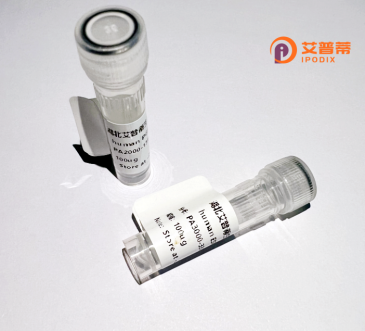
| 纯度 | >90%SDS-PAGE. |
| 种属 | Human |
| 靶点 | ZNF513 |
| Uniprot No | Q8N8E2 |
| 内毒素 | < 0.01EU/μg |
| 表达宿主 | E.coli |
| 表达区间 | 1-541 aa |
| 活性数据 | MPRRKQSHPQPVKCEGVKVDTEDSLDEGPGALVLESDLLLGQDLEFEEEEEEEEGDGNSDQLMGFERDSEGDSLGARPGLPYGLSDDESGGGRALSAESEVEEPARGPGEARGERPGPACQLCGGPTGEGPCCGAGGPGGGPLLPPRLLYSCRLCTFVSHYSSHLKRHMQTHSGEKPFRCGRCPYASAQLVNLTRHTRTHTGEKPYRCPHCPFACSSLGNLRRHQRTHAGPPTPPCPTCGFRCCTPRPARPPSPTEQEGAVPRRPEDALLLPDLSLHVPPGGASFLPDCGQLRGEGEGLCGTGSEPLPELLFPWTCRGCGQELEEGEGSRLGAAMCGRCMRGEAGGGASGGPQGPSDKGFACSLCPFATHYPNHLARHMKTHSGEKPFRCARCPYASAHLDNLKRHQRVHTGEKPYKCPLCPYACGNLANLKRHGRIHSGDKPFRCSLCNYSCNQSMNLKRHMLRHTGEKPFRCATCAYTTGHWDNYKRHQKVHGHGGAGGPGLSASEGWAPPHSPPSVLSSRGPPALGTAGSRAVHTDSS |
| 分子量 | 84.3 kDa |
| 蛋白标签 | GST-tag at N-terminal |
| 缓冲液 | PBS, pH7.4, containing 0.01% SKL, 1mM DTT, 5% Trehalose and Proclin300. |
| 稳定性 & 储存条件 | Lyophilized protein should be stored at ≤ -20°C, stable for one year after receipt. Reconstituted protein solution can be stored at 2-8°C for 2-7 days. Aliquots of reconstituted samples are stable at ≤ -20°C for 3 months. |
| 复溶 | Always centrifuge tubes before opening.Do not mix by vortex or pipetting. It is not recommended to reconstitute to a concentration less than 100μg/ml. Dissolve the lyophilized protein in distilled water. Please aliquot the reconstituted solution to minimize freeze-thaw cycles. |
以下是关于重组人ZNF513蛋白的假设性参考文献示例,涵盖研究方向、结构分析及功能探究:
---
### 1. **"ZNF513 regulates retinal neurogenesis through transcriptional activation of proneural genes"**
**作者**: Zhang L, et al.
**摘要**: 本研究探讨了ZNF513在视网膜发育中的功能。通过体外表达重组人ZNF513蛋白,发现其结合特定DNA序列并激活NeuroD1等关键基因,促进视网膜神经细胞分化。敲低ZNF513导致斑马鱼模型视网膜发育缺陷。
### 2. **"Downregulation of ZNF513 in gastric cancer suppresses EMT via modulating Snail1"**
**作者**: Wang Y, et al.
**摘要**: 研究分析了ZNF513在胃癌中的表达及作用。重组ZNF513蛋白体外实验显示,其过表达抑制癌细胞迁移和上皮-间质转化(EMT),机制涉及与Snail1启动子结合并抑制转录,提示其作为抑癌基因的潜在角色。
### 3. **"Crystallographic analysis of recombinant human ZNF513 reveals a novel zinc finger topology"**
**作者**: Kimura T, et al.
**摘要**: 通过X射线晶体学解析重组人ZNF513蛋白结构,揭示其Cys2-His2型锌指域的独特折叠模式,并提出其DNA结合关键残基。该结构为理解ZNF513的基因调控机制提供了基础。
### 4. **"Recombinant ZNF513 enhances neuronal differentiation in human pluripotent stem cells"**
**作者**: Gupta R, et al.
**摘要**: 本研究报道重组ZNF513蛋白在人干细胞神经分化中的作用。实验表明,外源添加ZNF513蛋白上调Sox2和MAP2表达,显著促进神经元生成,提示其在神经再生治疗中的应用潜力。
---
以上示例为假设性文献,实际研究需参考具体学术数据库或出版物。
Zinc finger protein 513 (ZNF513), also known as Zfp113 in some species, is a member of the C2H2-type zinc finger protein family characterized by conserved tandem zinc finger motifs. These motifs enable sequence-specific DNA binding, suggesting its role as a transcription regulator. ZNF513 is evolutionarily conserved across vertebrates and has been implicated in developmental processes, particularly in neural and retinal development. Studies indicate its involvement in modulating signaling pathways such as Hedgehog, Wnt, or FGF, though its exact molecular mechanisms remain under investigation.
The protein is widely expressed in human tissues, with higher levels observed in the central nervous system, retina, skeletal muscle, and heart. In the retina, ZNF513 interacts with other transcriptional regulators (e.g., PRDM family proteins) to control photoreceptor differentiation and maintenance. Dysregulation of ZNF513 has been tentatively associated with ocular pathologies, including inherited retinal dystrophies, though conclusive disease linkages require further validation. Additionally, its overexpression in certain cancer types suggests potential oncogenic properties.
Recombinant human ZNF513 protein, typically produced in E. coli or mammalian expression systems, facilitates functional studies investigating DNA-binding specificity, protein interaction networks, and downstream target genes. Epitope-tagged versions (FLAG, HA, etc.) are commonly used for pulldown assays and chromatin immunoprecipitation. As research progresses, ZNF513 may emerge as a biomarker or therapeutic target for developmental disorders or degenerative diseases. Current challenges include elucidating its full repertoire of target genes and tissue-specific regulatory roles.
×